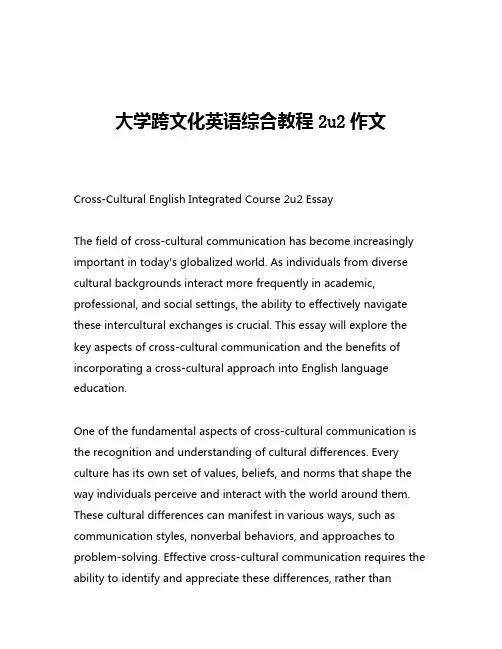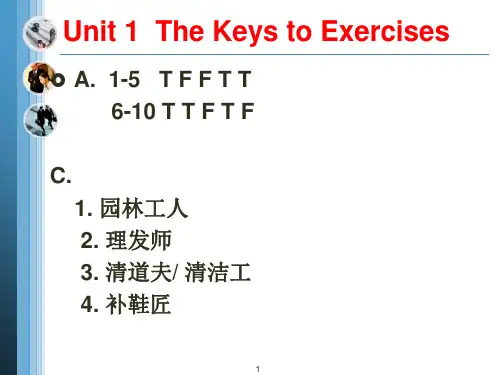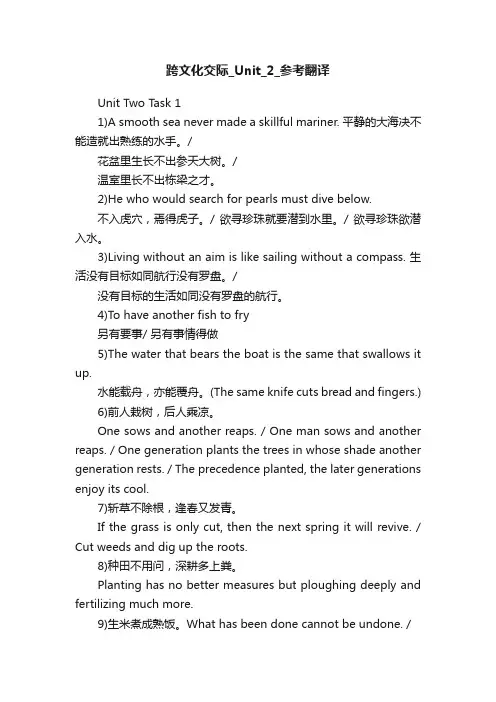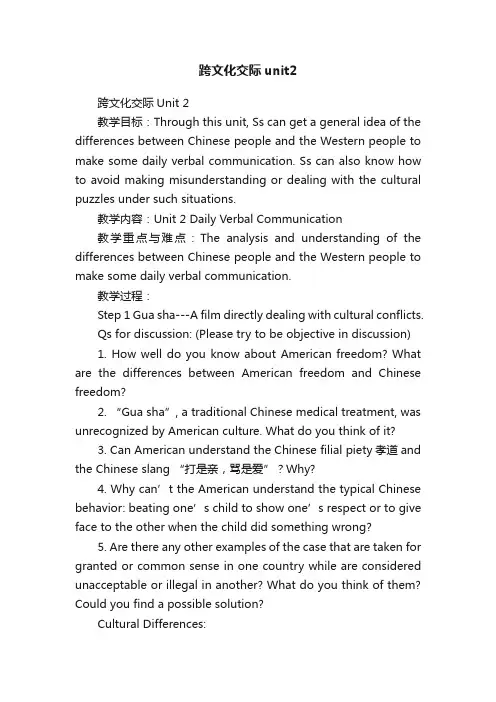大学跨文化交际Unit_2_Daily_Verbal_communication_I
- 格式:ppt
- 大小:4.45 MB
- 文档页数:75


大学跨文化英语综合教程2u2作文Cross-Cultural English Integrated Course 2u2 EssayThe field of cross-cultural communication has become increasingly important in today's globalized world. As individuals from diverse cultural backgrounds interact more frequently in academic, professional, and social settings, the ability to effectively navigate these intercultural exchanges is crucial. This essay will explore the key aspects of cross-cultural communication and the benefits of incorporating a cross-cultural approach into English language education.One of the fundamental aspects of cross-cultural communication is the recognition and understanding of cultural differences. Every culture has its own set of values, beliefs, and norms that shape the way individuals perceive and interact with the world around them. These cultural differences can manifest in various ways, such as communication styles, nonverbal behaviors, and approaches to problem-solving. Effective cross-cultural communication requires the ability to identify and appreciate these differences, rather thanmaking assumptions or judgments based on one's own cultural lens.In the context of English language education, a cross-cultural approach can provide students with the necessary skills and knowledge to navigate diverse linguistic and cultural environments. By exposing students to a range of cultural perspectives and communication styles, they can develop a more nuanced understanding of the English language and its use in various contexts. This not only enhances their linguistic competence but also fosters intercultural competence, enabling them to communicate effectively with individuals from different cultural backgrounds.Moreover, a cross-cultural approach to English language education can have significant benefits for students' personal and professional development. In today's interconnected world, the ability to communicate effectively across cultures is highly valued in a wide range of fields, from business and international relations to academia and the arts. By incorporating cross-cultural communication into the curriculum, students can gain a competitive edge in the job market and be better prepared to succeed in their future endeavors.One key aspect of a cross-cultural English language curriculum is the inclusion of authentic materials and resources that reflect diverse cultural perspectives. This can include literature, films, news articles, and other media that showcase the richness and complexity ofdifferent cultural traditions and communication styles. By engaging with these materials, students can develop a deeper understanding of the cultural context in which the English language is used, and learn to navigate the nuances of cross-cultural communication.Additionally, a cross-cultural approach to English language education should emphasize the development of intercultural competence. This involves the ability to recognize and respect cultural differences, to communicate effectively with individuals from diverse backgrounds, and to adapt one's communication style and behavior to suit the cultural context. By focusing on these skills, students can become more adept at navigating the challenges and opportunities presented by cross-cultural interactions.Another important aspect of a cross-cultural English language curriculum is the incorporation of collaborative learning and group activities. By working in diverse teams, students can learn to navigate the complexities of cross-cultural communication, develop empathy and understanding for different perspectives, and practice the skills necessary for effective collaboration in a globalized world.Furthermore, a cross-cultural approach to English language education should also address the role of language in the construction and expression of cultural identity. As students explore the relationship between language and culture, they can gain adeeper appreciation for the ways in which language shapes and is shaped by cultural norms and values. This understanding can not only enhance their linguistic skills but also foster a greater respect for cultural diversity and a commitment to intercultural understanding.In conclusion, the incorporation of a cross-cultural approach into English language education is crucial in today's globalized world. By exposing students to diverse cultural perspectives, developing their intercultural competence, and emphasizing the relationship between language and culture, educators can equip students with the skills and knowledge necessary to navigate the complexities of cross-cultural communication. This, in turn, can lead to greater personal and professional success, as well as a more just and equitable global society.。






跨文化交际_Unit_2_参考翻译Unit Two Task 11)A smooth sea never made a skillful mariner. 平静的大海决不能造就出熟练的水手。
/花盆里生长不出参天大树。
/温室里长不出栋梁之才。
2)He who would search for pearls must dive below.不入虎穴,焉得虎子。
/ 欲寻珍珠就要潜到水里。
/ 欲寻珍珠欲潜入水。
3)Living without an aim is like sailing without a compass. 生活没有目标如同航行没有罗盘。
/没有目标的生活如同没有罗盘的航行。
4)To have another fish to fry另有要事/ 另有事情得做5)The water that bears the boat is the same that swallows it up.水能载舟,亦能覆舟。
(The same knife cuts bread and fingers.)6)前人栽树,后人乘凉。
One sows and another reaps. / One man sows and another reaps. / One generation plants the trees in whose shade another generation rests. / The precedence planted, the later generations enjoy its cool.7)斩草不除根,逢春又发青。
If the grass is only cut, then the next spring it will revive. / Cut weeds and dig up the roots.8)种田不用问,深耕多上粪。
Planting has no better measures but ploughing deeply and fertilizing much more.9)生米煮成熟饭。


跨文化交际unit2跨文化交际Unit 2教学目标:Through this unit, Ss can get a general idea of the differences between Chinese people and the Western people to make some daily verbal communication. Ss can also know how to avoid making misunderstanding or dealing with the cultural puzzles under such situations.教学内容:Unit 2 Daily Verbal Communication教学重点与难点:The analysis and understanding of the differences between Chinese people and the Western people to make some daily verbal communication.教学过程:Step 1 Gua sha---A film directly dealing with cultural conflicts.Qs for discussion: (Please try to be objective in discussion)1. How well do you know about American freedom? What are the differences between American freedom and Chinese freedom?2. “Gua sha”, a traditional Chinese medical treatment, was unrecognized by American culture. What do you think of it?3. Can American understand the Chinese filial piety孝道and the Chinese slang “打是亲,骂是爱”?Why?4. Why can’t th e American understand the typical Chinese behavior: beating one’s child to show one’s respect or to give face to the other when the child did something wrong?5. Are there any other examples of the case that are taken for granted or common sense in one country while are considered unacceptable or illegal in another? What do you think of them? Could you find a possible solution?Cultural Differences:(1)American Dream VS Chinese Dream●House, car, a stable well-paid job.● A well-known saying-----“Where the re is no vision, the people perish.Where there is no vision, the America people will perish.”(Cliton, at a presidential election campaign in 1995) Characteristics of American Dream:● a kind of wish (Tomorrow will be better than today.)●reality and action (e.g. gold rush)●lack of artistic flavor (in Chinese’s eyes)●part of American spiritChinese:* Real, a dream forever* Waiting for a prince or princess (白雪公主与白马王子), or waiting for being discovered or promoted. (孔明,姜子牙) * a perfect dream, Utopia, related to hermitage travel赫米蒂奇旅行, leisure, Chinese painting, calligraphy 书法* Characteristics: passive; idealistic, quite spiritual, perfectOpen question: What lead to these differences?(2)American freedom VS Chinese freedomAlcoholic drinks (less than 21, forbidden)Cigarette smoking (less than 18, forbidden in cities)Children below 12 at home along (illegal)Job interview (not to be asked about such info as handicapped, birth place; marital status; age;immigrant info, child info, crime records; etc.)***Additional things: sexual harassment; gender discrimination; ethnic discrimination; moral evaluation; Chinese: good or bad, American: legal or illegal.Open Qs: How about Chinese freedom?What do you think of ruling country by law as well as by De? (依法治国,以德治国)Step 2: Presentation of the textPart 1: Form of Address2.1 Naming names(1) To make a comparison between a Chinese name and an English one.E.g. Zhou Xingchi Andrew Lewissurname (family name) given name given name surname (family name)(2) For most English people, they have 3 names (Christian name + Given name + Surname) and the first of the given names is usually used by them.E.g. Anthony John Ward(4) Sources of some names(5) Partents should be careful of giving names to their children:Nichola Ann Green: This is a girl's name with the initials NAG, which unfortunately spell the word meaning to continually complain in an irritating wa y, e.g., '“My wife never stops complaining. She nags me morning, noon, and night.”Fiona Alice Tanner: This is a girl's name with the initials FAT.Michael Adam Davies: This is a boy's name with the initials MAD.Peter Ewan Steven Thompson: This is a boy's name with the initials PEST.Graham Adam Yiend: This is a boy's name with the initials GAY. This has a number of different meanings. In the past it was simply used to mean 'happy', so would not have been avoided.Nowadays, however, it has acquired another meaning and is more frequently used to mean 'male homosexual'.Part 2: Addressing (P.22-25)Discussion:What are the most common forms of address for a man named “ Zhou Xingchi”?What are the common forms of address for a man named “Andrew Lewis”?What kind of mistakes may Chinese speakers make when addressing foreigners? Reasons? (To see the case on p.37:3) Three-step approach:分析方法:A “three-step approach” to case analysis isrecommended in this course. You may follow the three steps below when analyzing cross-cultural cases.Step 1: Normative-level analysis主要是进行背景分析,从书中理论着手At this step, these questions need to be addressed: what cultural differences made the involved parties behave in this way? What normative cultural attributes caused the cross-cultural clash? Step 2: Behavioral-level analysis行为分析,从文化差异入手。

Cross-Cultural Communication in theUniversity ContextIn the globalized world of today, cross-cultural communication has become an integral part of university education, particularly in the field of English language learning. As students from diverse cultural backgrounds converge on campus, the importance of understanding and respecting cultural differences becomes paramount. This essay explores the challenges and opportunities of cross-cultural communication in the university setting, focusing on the experiences and learnings from "University Intercultural English Integrated Course 2 Unit 2."Firstly, cross-cultural communication presents a unique set of challenges to university students. Language barriers can often lead to misunderstandings and awkward situations. For instance, directness in communication may be valued in some cultures, while indirectness is preferred in others. Understanding these nuances of cultural communication is crucial for effective interpersonal interactions.Moreover, the diverse range of cultural values and beliefs can pose significant challenges. Concepts that areconsidered taboo or inappropriate in one culture may be commonplace in another. It is, therefore, essential for university students to develop a sense of cultural sensitivity and awareness to avoid offending or embarrassing others.However, despite these challenges, cross-cultural communication also offers invaluable opportunities for personal growth and intellectual development. Interacting with people from different cultures broadens one's perspective and enhances understanding of the world's diversity. It cultivates a global mindset that is essential for success in today's interconnected world.The "University Intercultural English Integrated Course 2 Unit 2" provides a platform for exploring these challenges and opportunities. Through a variety ofactivities and discussions, it encourages students to reflect on their own cultural biases and assumptions. It also equips them with the skills and knowledge necessary to navigate cross-cultural interactions gracefully and confidently.In conclusion, cross-cultural communication is an essential skill for university students in the 21st century. While it presents unique challenges, it also offers remarkable opportunities for personal and intellectual growth. By embracing diversity and fostering a culture of inclusivity, universities can prepare their students to become global citizens who are capable of effective cross-cultural communication.**跨文化交流在大学环境中的重要性**在全球化日益盛行的今天,跨文化交流已成为大学教育的重要组成部分,尤其是在英语学习领域。
Chapter 2 Communication and InterculturalCommunicationI. Teaching ObjectivesIn this chapter, the teacher should enable the students to:1. know different definitions of communication.2. identify nine components of communication.3. identify the characteristics of communication.4. know the relationship between culture and communication.5. know the definition of intercultural communication.6. identify the 4 forms of intercultural communication.II. Contents1. Keywords(1) Sender/Source: A sender/source is the person who transmits a message.(信息发出者/信息源:信息发出者/信息源指传递信息的人。
)(2) Message: A message is any signal that triggers the response of a receiver.(信息:信息指引起信息接受者反应的任何信号。
)(3) Encoding: It refers to the activity during which the sender must choose certain words or nonverbal methods to send an intentional message. (编码:编码指信息发出者选择言语或用非言语的方式发出有目的的信息的行为。